

M is for Mulready Envelopes - Page 1 |

|

|

|

|
Mulready envelopes are elaborately decorated, pre-paid envelopes and letter sheets issued in the UK in 1840, at the same time as the Penny Black, the world's first postage stamp. Issued in both one-penny and two-penny denominations, the Mulreadys were regarded by many people of the time as an embarrassing Folly. Apparently their elaborate, fanciful design was considered paternalistic and condescending, hence they saw little use, and were withdrawn, but are popular collectibles now. They are essentially the earliest stamped envelopes. Rowland Hill, their sponsor (and the man generally considered the inventor of the postage stamp), expected them to be the primary vehicle for letters, and issued stamps as well almost as an afterthought. But the public preferred stamps. Most of the Mulready stock had to be destroyed, making them rather scarce today - expect to pay around $100 for a decent mint copy.
Despite their failure, we have the Mulreadys to thank for other popular collectibles. Many amusing and fanciful imitations, parodies, and lampoons were published, leading to a long tradition of beautiful illustrated envelopes, both printed, and hand-drawn. Moreover, their status as "Firsts" has given them a place in the hearts of collectors, and led to their reproduction for many purposes over the years.
Keep in mind that the Mulreadys and Penny Blacks were part of a major postal reform, in which the rate scale was dramatically revised, from a system based on the number of sheets of paper and the mileage, to one based simply on weight. It was called Island Penny Postage (also Inland Penny Postage, and Uniform Penny Post), which meant that all letters sent within the UK went for a single fixed rate of One Penny per half-ounce. (See reproduction of full letter-sheet below for all the details of rates and regulations - quite interesting.)
Click on any image below to view a high-res version
Mulreadys


The Mulready (Artist/Designer, William Mulready; Engraver, John Thompson;
Printers, William Clowes & Sons) was issued in two denominations, One Penny (black
ink on cream paper) and Two Pence (blue ink on cream paper), in two different colors to
distinguish the denominations, and in two different formats - unfolded envelopes and
unfolded letter sheets. Envelopes were still a novelty at the time, as the prior
postal rates had been based not on weight but on the number of sheets of paper,
and an envelope counted as one sheet, doubling the rate.
Note that there is no stamp or indicium in the design,
merely the postage value printed at the bottom. It was only later, when
stamps became the standard way to pay postage, that stamp-like images were
printed on postal stationery. Usages like the ones above, in combination with the One-Penny
and Two-Pence stamps, are particularly sought by collectors.
The cover on the left above is a wonderful rarity, a Mulready envelope with a Penny Black,
cancelled on their joint Day of Issue, May 6, 1840,
making this the First
First Day cover of all of Philately! Sold for $18,500 + 10%" in 1999.
Mulready Letter Sheets

Here's what the Two Pence letter sheet looked like unfolded, and below are enlargements
of all the text. I suspect this text was a significant part of the reason for the
reaction to the Mulreadys - people resented the implication that they needed everything
spelled out; but I am glad from this perspective of time to have all these interesting
details set down.


Or perhaps the public distaste was a matter of simple economy - a quarter penny per
envelope for singles was probably a lot at the time. One could still use a folded letter
sheet, sealing wax, and one of the new stamps, and save the extra cost for the envelope.
Hand Tinted Mulreadys

Some people seemed to like the new design, and enhanced it with hand coloring. Examples
such as this, with its clear, well-placed Maltese Cross cancel, sell for thousands of
dollars.
Mulready Parodies, Lampoons & Caricatures
"Everybody has, we presume, before this time, had an opportunity of examining those very extraordinary specimens of British Art - the penny-post envelopes. On the merits of the design for those absurdities we have never heard but one opinion. From Sir Robert Peel down to the lowest kitchen wench the new covers have been laughed at by every man, woman, and child of the community who has the slightest perception of the ludicrous. Anything more ridiculous could hardly be imagined..."
(London Times, September 2, 1840)
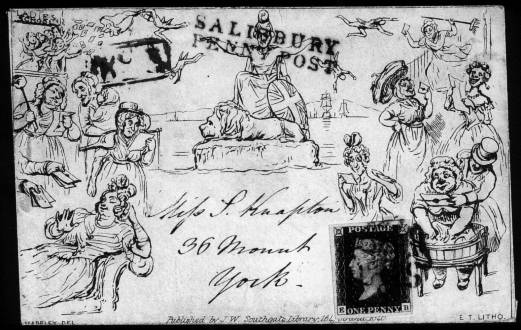
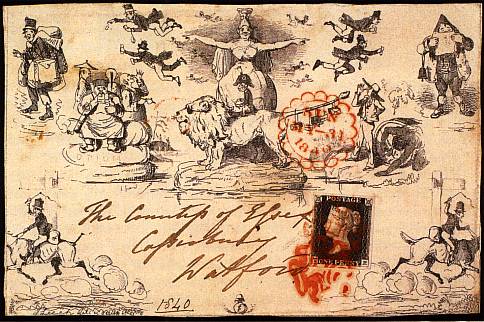
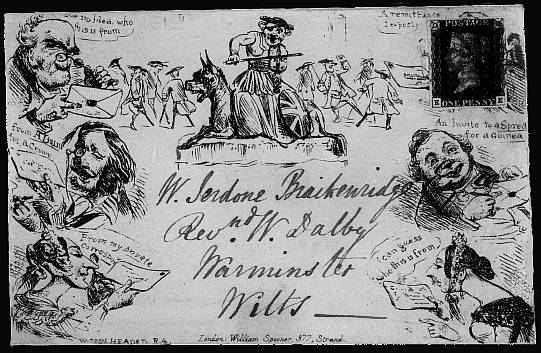


Much of the public shared the reaction to the Mulready of the writer of that
Times editorial and the publishers of these parodies, which sold among them many
more copies than the item they caricatured. Many are scarce and valuable today. There
is an entertaining and informative book, "The Mulready Envelope & Its Caricatures" by
Major E B Evans (first published in 1891), which recounts the history of the Mulreadys
themselves, and explains the meanings of the Imitations and Parodies, most of which are
obscure to the modern viewer. For example his description of the details of the
Southgate No.2, the first one above (with 1d black, addressed to York) starts as follows:
And his description of the third envelope, number 3 of a famous series published by William Spooner, begins thus:"No 2 shows Britannia sending out letters to the gentler sex of all ranks. In the left upper corner a whole bag full goes to a 'Ladies School'; below are a cook and a milk woman reading letters, and a fine lady refusing the billets doux that are handed to her........"
I suspect some of those "divers figures" may resemble famous personages of the era, but no word from Evans on that."Britannia is shown as a fiddler, with a patch over one eye, seated on the back of a recumbent donkey, which is singing to the music; in the background is a group of wooden- legged dancers. Divers single figures at the sides are speculating upon the contents of their letters..."
Mulready Exhibit


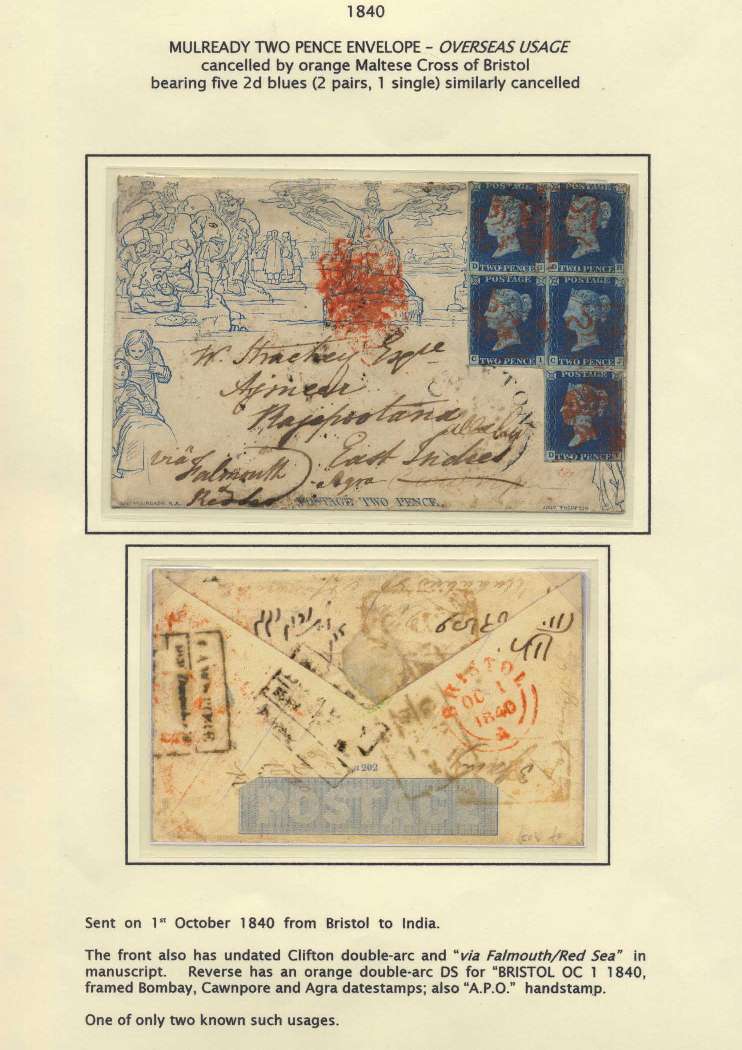
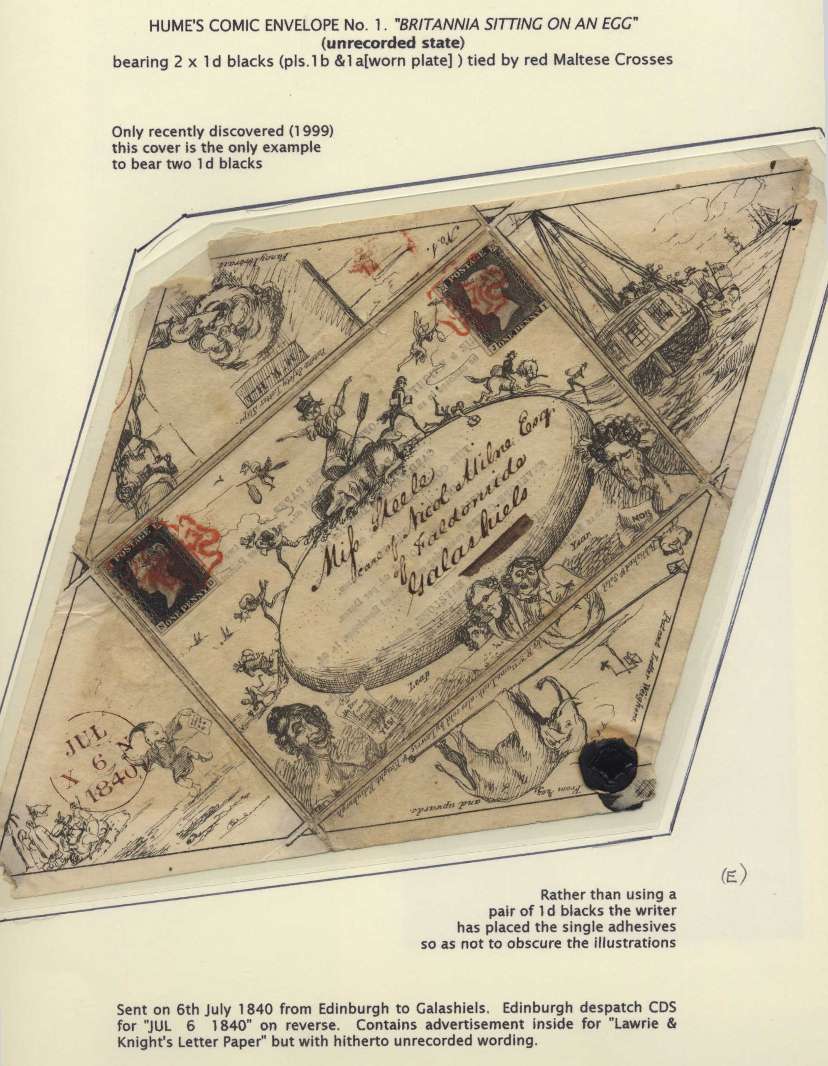
A well-known collector of Mulreadys sent me scans of some pages from his award-winning
collection, which I am sharing with you above, as I think these four pages convey a
useful idea of what it takes to win awards exhibiting. One needs to show first the
development of the concept, as in the House of Lords envelope, then early uses, standard
uses, unusual uses, and in this case, parodies. It helps a lot to have the rarest and
best examples, which you can see these are. Read the text on the pages for explanations
about the items. The owner added the following:
1) House of Lords Envelope - the government issued 3 types of provisional envelopes for use in the Houses of Parliament as a temporary measure in January 1840, when neither postal stationery nor adhesive postage stamps were ready. The rarest of these, by far, is the House of Lords envelope.
2) May 5th 1840 Mulready - pre-authorised use. I also have a May 2nd but it is not as nice, albeit it is very rare!
3) 2d Mulready to India bearing 5x 1840 2d blues.
4)Hume caricature (Scottish) "Brittania sitting on an Egg" bearing 2x1d blacks.
| Home | L is for Local Stamp <<< | Contents | >>> M - Page 2 | Credits |
All Letter images Copyright © 1997, 2000, SF chapter of AIGA
All text Copyright © 2000, William M. Senkus
Send feedback to the webmaster: CLICK HERE
Revised -- 04/16/2003
